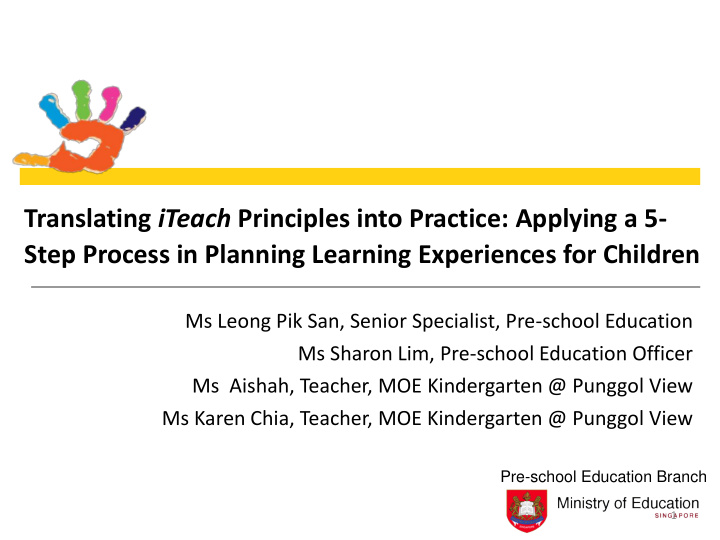



Translating iTeach Principles into Practice: Applying a 5- Step Process in Planning Learning Experiences for Children Ms Leong Pik San, Senior Specialist, Pre-school Education Ms Sharon Lim, Pre-school Education Officer Ms Aishah, Teacher, MOE Kindergarten @ Punggol View Ms Karen Chia, Teacher, MOE Kindergarten @ Punggol View Pre-school Education Branch 1
Outline • Nurturing Early Learners (NEL) Framework 1 • Understanding How Children Learn 2 • Translating Principles into Practice 3 – 5-step Teaching Process – 5-step Teaching Process in Practice • Sharing by MOE Kindergarten @ Punggol View 4 • Self Reflection 5 2
Nurturing Early Learners (NEL) Framework • Launched by MOE in 2013 • Provides broad guidelines - Belief about children - iTeach principles 3
Nurturing Early Learners (NEL) Framework 4
Understanding How Children Learn Children ask questions, investigate Exploration and make discoveries Acquisition Awareness Children transfer and apply Children become aware of learning in different contexts phenomenon and develop interest to find out more Application Children revise and refine their understanding and skills to make new connections 5
Translating Principles into Practice CONNECT to new learning EXTEND learning BUILD on REFLECT curiosity on learning INVITE interest Exploration Acquisition Awareness Application 6
5-Step Teaching Process • ignite children’s interest INVITE interest • tap on children’s prior knowledge • tap on children’s natural curiosity BUILD on • children explore and find out more curiosity • help children make connections between CONNECT to new learning prior knowledge and new learning 7
5-Step Teaching Process EXTEND • help children apply the skill in different learning contexts • engage children in reflection to think REFLECT back, learn from it and do it better on learning 8
5-step Teaching Process in Practice The activities in this segment are meant to help participants understand the 5-step teaching process and are not meant for children. 9
5-Step Teaching Process in Practice • Include element of surprise/ mystery/fun INVITE • Use story, rhyme, game, concrete object, interest picture or video • Possible prompts: “What do you notice/ see/hear/feel/smell?” 10
5-Step Teaching Process in Practice INVITE interest This is part of a picture. Guess what the picture is. 11
5-Step Teaching Process in Practice • Encourage wonderment and questions BUILD on • Provide concrete materials for exploration curiosity • Possible prompts: “I wonder why …”, “What do you think will happen if … . ” 12
5-Step Teaching Process in Practice BUILD on curiosity This story illustrates how people can have different view points when looking at the same situation. As the story is being read, think about how these different views came about and whether they can both be right. 13
5-Step Teaching Process in Practice • Teach concepts/skills and allow for CONNECT to practice new learning • Possible prompts: “What do you remember about …?”, “How are they the same or different?” 14
5-Step Teaching Process in Practice CONNECT to new learning What do you think this is? Add details to the drawing to convince others of what you think it is. Exchange views with your partner. What are learning points from this activity? • In many situations, there is more than one way to see things. • We should respect the views of others. 15
5-Step Teaching Process in Practice • Provide new situations/ contexts for EXTEND children to apply new knowledge learning • Possible prompts: “What would you do if …?” 16
5-Step Teaching Process in Practice EXTEND learning Besides pictures/visuals, stories can also be told from different perspectives. 17
5-Step Teaching Process in Practice • Think back on learning and how to do it REFLECT better on learning • Provide stimuli for thinking back (e.g. photos, video, artwork/model) • Modes of reflection can include drawing/creating, dramatising, using print (e.g. graphic organiser, writing story) • Possible prompts: “How did you feel about …?”, “How can we do it better/differently?” 18
Self Reflection 19
Self Reflection What squares with my thinking? What is still rolling around in my head? How can I apply what I have learnt? 20
Recommend
More recommend